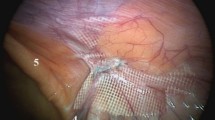Abstract
Background
Tension-free inguinal hernia repair is one of the so-called painless operations. Mild or medium postoperative pain, however, even in the mesh repair era, is common and usually due to ilioinguinal nerve entrapment or mesh fixation in the periostium of the pubic tubercle. Especially in indirect inguinal hernia repair, however, hernia sac ligation and excision may be the cause of pain. The aim of this study was to conduct a single-center prospective randomized trial with a view to clarify this issue on a scientific basis.
Methods
In an 8-year period, all patients undergoing elective indirect inguinal hernia repair using a tension-free polypropylene mesh technique were randomized to induce high hernia sac ligation or not in a double blind manner. The main endpoint was to detect any difference in postoperative pain between the two groups.
Results
Between January 1999 and December 2006, 477 patients with indirect inguinal hernia entered the study and were randomized to have high hernia sac ligation and excision (group A, n = 238) or not (group B, n = 239). The two groups were comparable regarding demographic data. Postoperative pain was associated with statistically significantly more episodes in group 1, 27% (65/238), than in group 2, 10% (24/239), on day 1, 9% (22/238), compared to 3% (8/239) on day 7, 2% (5/238), compared to 0% (0/239), on day 30, respectively, and these results were statistically significant (P ≤ 0.05). All patients were treated conservatively.
Conclusion
From the results of this study, it appears that we are able to demonstrate a significant benefit from the omission of high hernia sac ligation and excision on postoperative pain in patients who undergo tension-free indirect inguinal hernia mesh repair.
Similar content being viewed by others
References
Callesen T (2003) Inguinal hernia repair: anaesthesia, pain and convalescence. Dan Med Bull 50(3):203–218
Page B, Paterson C, Young D, O’Dwyer PJ (2002) Pain from primary inguinal hernia and the effect of repair on pain. Br J Surg 89(10):1315–1318
Lau H, Lee F (2001) Determinant factors of pain after ambulatory inguinal herniorrhaphy: a multiple-variate analysis. Hernia 5(1):17–20
Callesen T, Bech K, Nielsen R, Andersen J, Hesselfeldt P, Roikjaer O, Kehlet H (1998) Pain after groin hernia repair. Br J Surg 85(10):1412–1414
Kumar S, Wilson RG, Nixon SJ, Macintyre MC (2001) Chronic pain after laparoscopic and open mesh repair of groin hernia. Br J Surg 88(Suppl 1):81
Callesen T, Bech K, Andersen J, Nielsen R, Roikjaer O, Kehlet H (1999) Pain after primary inguinal herniorrhaphy: influence of surgical technique. J Am Coll Surg 1999 188(4):355–359
Sanchez-Manuel FJ, Seco-Gil JL (2004) Antibiotic prophylaxis for hernia repair. Cochrane Database Syst Rev 18(4):CD003769
Stephenson BM (2003) Complications of open groin hernia repair. Surg Clin North Am 83(5):1255–1278
Mann DV, Prout J, Havranek E, Gould S, Darzi A (1998) Late-onset deep prosthetic infection following mesh repair of inguinal hernia. Am J Surg 176(1):12–14
Taylor SG, O’Dwyer PJ (1999) Chronic groin sepsis following tension-free inguinal hernioplasty. Br J Surg 86(11):1482
Usher FC (1963) Hernia repair with knitted polypropylene mesh. Surg Gynecol Obstet 117:139–140
Arnaud JP, Eloy R, Adloff M, Grenier JF (1977) Critical evaluation of prosthetic materials in repair of abdominal wall hernias. Am J Surg 133:338–345
Bellon JM, Bujan I, Contreras L, Juranto F (1994) Macrophage response to experimental implantation of polypropylene prostheses. Eur Surg Res 26:46–53
Dougherty SH (1986) Implant infection. In: Von Recum AF (eds) Handbook of biomaterials evaluation. Macmillan, New York, pp 276–289
Gilbert AI, Felton LL (1993) Infection of inguinal hernia repair considering biomaterials and antibiotics. Surg Gynecol Obstet 177:126–130
Bay-Nielsen M, Nilsson E, Nordin P, Kehlet H (2004) Chronic pain after open mesh and sutured repair of indirect inguinal hernia in young males. Br J Surg 91(10):1372–1376
Nienhuijs SW, Boelens OB, Strobbe LJ (2005) Pain after anterior mesh hernia repair. J Am Coll Surg 200(6):885–889
Starling JR, Harms BA (1989) Diagnosis and treatment of genitofemoral and ilioinguinal neuralgia. World J Surg 13:586–591
Ziprin P, Williams P, Foster ME (1999) External oblique aponeurosis nerve entrapment as a cause of groin pain in the athlete. Br J Surg 86(4):566–568
Kumar S, Wilson RG, Nixon SJ, Macintyre MC (2001) Chronic pain after laparoscopic and open mesh repair of groin hernia. Br J Surg 88(Suppl 1):81
Aasvang E, Kehlet H (2005) Surgical management of chronic pain after inguinal hernia repair. Br J Surg 92(7):795–801
Author information
Authors and Affiliations
Corresponding author
Rights and permissions
About this article
Cite this article
Delikoukos, S., Lavant, L., Hlias, G. et al. The role of hernia sac ligation in postoperative pain in patients with elective tension-free indirect inguinal hernia repair: a prospective randomized study. Hernia 11, 425–428 (2007). https://doi.org/10.1007/s10029-007-0249-9
Received:
Accepted:
Published:
Issue Date:
DOI: https://doi.org/10.1007/s10029-007-0249-9




